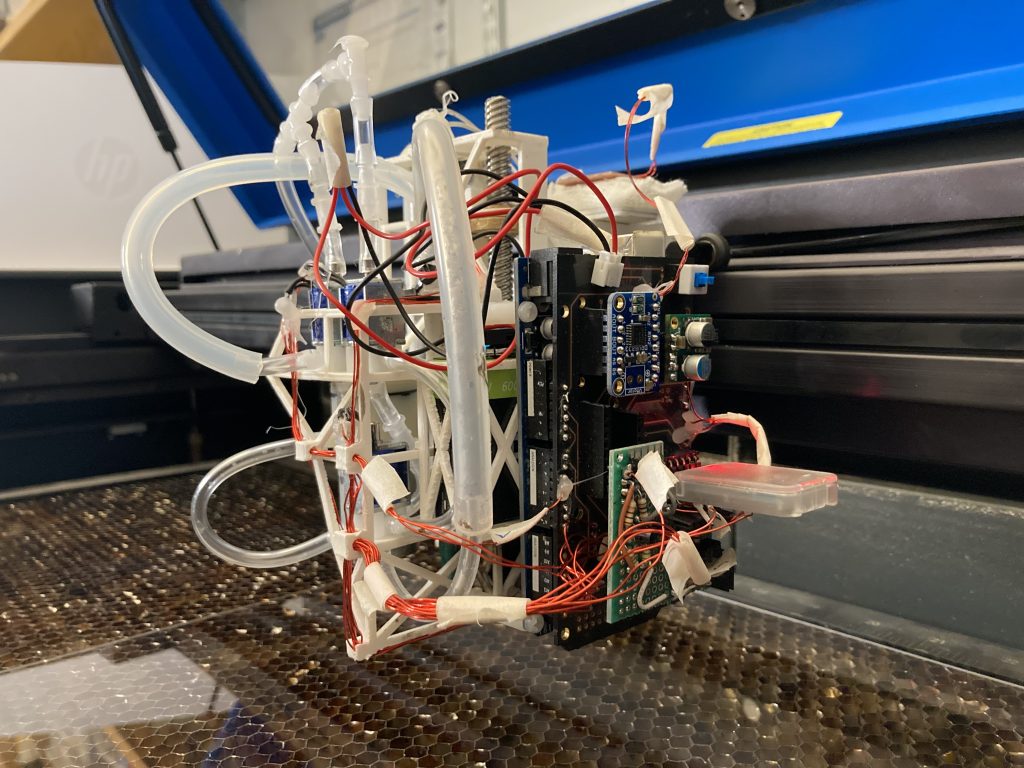A team of researchers from MIT’s Computer Science and Artificial Intelligence Laboratory (CSAIL) have developed a hardware add-on that transforms commercial laser cutting systems into hybrid 3D printers.
Dubbed LaserFactory, the electromechanical assembly attaches to a laser cutter’s head, resulting in a comprehensive fabrication platform that can be used to create fully functional electronic devices such as robots. Working in conjunction with the original system’s laser cutting functionality, the LaserFactory assembly features a silver paste extrusion system for electrical connections and a mechanism for picking up and placing components such as batteries, LEDs, and motors.
Martin Nisser, lead author of the paper, states, “Making fabrication inexpensive, fast, and accessible to a layman remains a challenge. By leveraging widely available manufacturing platforms like 3D printers and laser cutters, LaserFactory is the first system that integrates these capabilities and automates the full pipeline for making functional devices in one system.”

How does LaserFactory work?
LaserFactory grants users three core abilities. The laser cutting aspect of the system allows users to cut out structural geometries from a block of acrylic, the silver paste extruder enables electrical connections, and the pick-and-place mechanism allows for electronic component assembly. Beyond just the hardware platform, the CSAIL researchers have also developed a purpose-built software toolkit that can be used to design the custom devices before they are 3D printed.
Looking at an example of a quadcopter drone, the user would first have to design the robot by picking out and placing all of the necessary components (propellers and batteries) from a part library in the LaserFactory design program. Then, the electrical circuit traces between the components would be drawn and the drone’s cut and fold lines would be finalized in the 2D editor. The software also allows users to etch grooves into the devices and fill them with silver paste, essentially enabling printed circuit boards (PCBs) with embedded electronics.
Once the design is complete, the user previews the entire device before the software translates it into machine instructions in a process akin to slicing. The cutting, dispensing, picking up, placing, and trace soldering are all completely automated. In the case of the drone, the device would be fully functional and ready to take off straight from the build chamber.

Robotics for the masses
While the current iteration of LaserFactory is best suited for makers, researchers, and educators seeking rapid prototyping, the CSAIL researchers can see it being used by the general population in the near future. With plans to increase the quality and resolution of the circuit traces, the team expects the system to allow for denser and more complex electronic devices such as delivery rovers and search-and-rescue drones.
Nisser adds, “Beyond engineering, we’re also thinking about how this kind of one-stop shop for fabrication devices could be optimally integrated into today’s existing supply chains for manufacturing, and what challenges we may need to solve to allow for that to happen. In the future, people shouldn’t be expected to have an engineering degree to build robots any more than they should have a computer science degree to install software.”

In a similar project, MIT CSAIL researchers have previously developed a novel 3D design environment that enables users to digitally model embedded electronics. MorphSensor draws from both conventional CAD software and circuit building software to enable custom mechatronic components to be designed for 3D printing.
More recently, MIT scientists designed and tested a novel 3D printed ion-emitting satellite propulsion system. The tiny thruster, which is believed to be the first entirely 3D printed device of its kind, fires charged ionic particles from emitter cones along its outer shell, giving it a few micronewtons of propulsion in space. The team believes this power could prove sufficient in making it a low-cost and efficient alternative to conventional CubeSat engines.
Subscribe to the 3D Printing Industry newsletter for the latest news in additive manufacturing. You can also stay connected by following us on Twitter and liking us on Facebook.
Looking for a career in additive manufacturing? Visit 3D Printing Jobs for a selection of roles in the industry.
Featured image shows the LaserFactory hardware add-on. Photo via MIT CSAIL.



